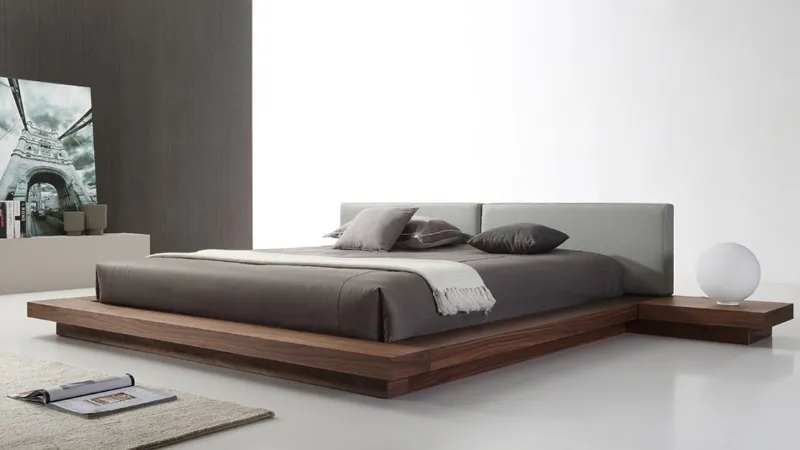What is a platform bed? Below will give you the pros and cons and types of platform beds. Helping you to decide which one is better for you when talking to platform beds vs. box springs.
A platform bed is a low-profile bed frame that supports the mattress from the bottom up with a strong base (either solid, metal, or slatted). A platform bed is special because it does not need a box spring.
Therefore, there is no need to buy any additional accessories after you buy it; it is ready to use. In addition to a mattress foundation or box spring, other traditional bed frames, such as four-poster beds or canopy beds, would also require one.
Continue reading to find out more.
What is a Platform Bed?
The platform bed, also called a cabin bed in the business, has a raised, low-profile frame that holds a mattress. Platform beds generally sit lower to the ground compared to most traditional bed frames and box springs, and platform beds are usually between 5 to 12 inches in height.
The ability to sleep comfortably on a mattress without the need for a box spring or separate foundation is one of the platform bed’s most notable features. Platform beds can also come with a headboard, footboard, and extra storage drawers at the foot or under the bed.
Platform beds are created to accommodate typical mattress sizes, just like standard bed frame sizes.
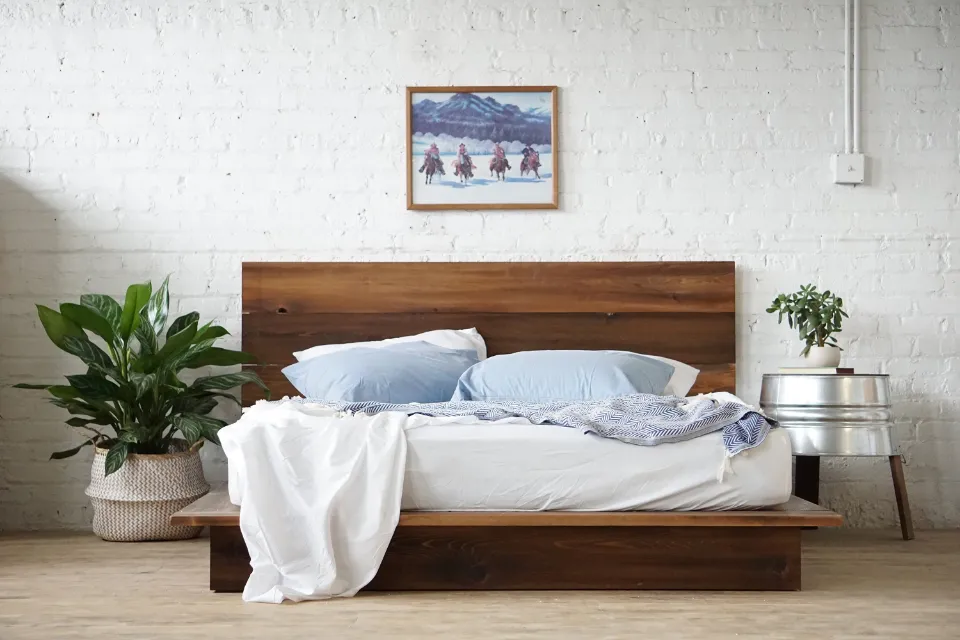
Platform Bed Benefits
There are many advantages that platform beds can provide for sleepers. First and foremost, platform beds are affordable and ergonomic compared to other beds. They’re also fairly compact and ideal for small bedrooms or apartments with limited storage space.
Platform beds with slats allow for flexible comfort customization because the slats can be moved to better suit different sleeping preferences. Better airflow and mattress breathability are also made possible by the same slats. Solid platform beds, on the other hand, are preferable for supporting people who weigh more when they sleep.
Platform Bed Drawbacks
Platform beds might not be the best option for seniors or those who have asthma because of how close to the ground they are. Platform beds are generally heavier and more difficult to move and relocate than other beds, so they might not be the best choice for people who move frequently or like to rearrange their bedrooms frequently.
Platform beds tend to be too firm for people who prefer a soft, contouring surface to sleep on. Additionally, since solid platform beds don’t allow much airflow beneath the mattress, some sleepers may find that their surroundings are too warm.
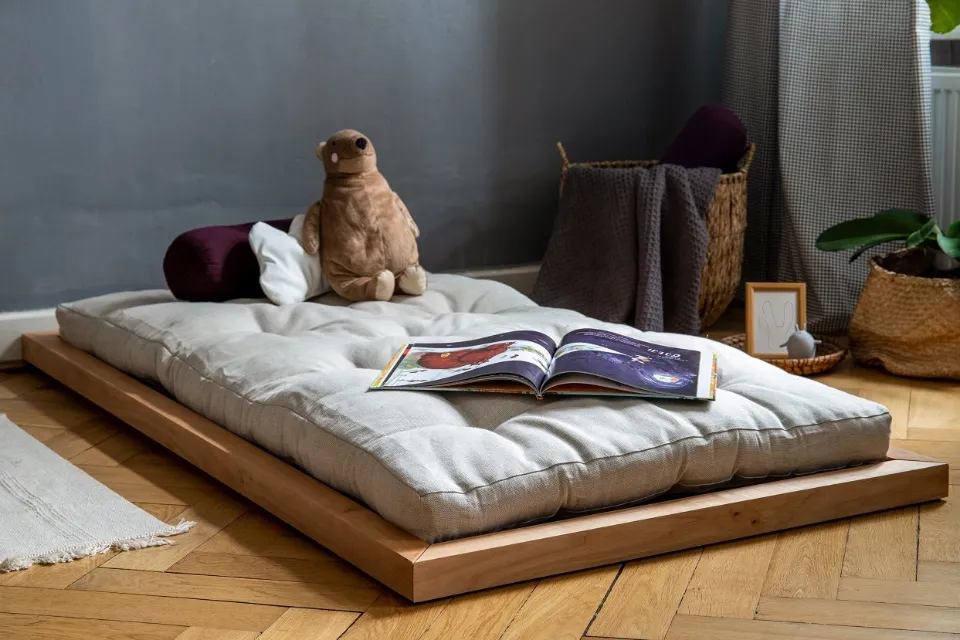
Types of Platform Beds
There are many different types of bed frames that can be called a “platform bed.” A metal grid or a solid piece of wood could serve as the platform. It could be made from a composite material or a modern plastic. There is no shortage of platform bed variations, but the function of all platform bed frames is the same—to support the mattress using material on a single plane.
There are four main types of platform beds: solid, slat, metal, and For budget-conscious sleepers, DIY.
Solid Platform Bed
The traditional platform bed is made of a solid material that you can lay your mattress directly on and does not require the use of a boxspring. (Always check the warranty on your mattress before skipping the boxspring. Depending on the business, some manufacturers might demand the boxspring.)
Wood, metal, plastic, or even a composite material can be used as this solid material. Metal will be the strongest of these four materials and provide the least amount of resistance and play in the frame.
Slat Platform Bed
Slats are used in place of a solid surface in a platform bed frame. These slats, like the solid platform, can be made of wood, metal, plastic, or a composite material. The actual slats may come rigid or flexed. However, you usually only will find flex slats in wood frames (also know as a “euro-base” or “euro-style” slat frame).
Slats that have been bent will come out bowed to balance the weight of the mattress and the occupants. On the other hand, rigid slats will be straight and offer no give. In general, a rigid slat system will provide a stronger structural foundation.
Regarding spacing, slats may be up to 6″ apart, depending on the width and thickness of each individual slat. The strength of the entire assembly will increase with the spacing between the slats. As a general rule, slats gaps of 3″ or less are considered ideal.
Metal Platform Bed
Although the support is the same, this style of platform bed offers a slightly more utilitarian appearance. This assembly uses a steel support with rigid secondary steel or wire supports to form the platform.
This metal platform bed offers a sturdy support for a mattress or mattress and boxspring set when properly spaced.
Although a boxspring is not typically required for these types of frames, metal platform beds can also be used with one.
DIY Platform Bed
In search of a platform bed on a tighter budget? Although many manufacturers provide less expensive platform bed options, if you’re in a bind, it’s fairly easy to make your own platform.
It won’t be elegant or fashionable, but it will be encouraging. Take a basic metal bed frame and add a 3/4″ sheet of plywood cut to the size of your bed frame. You may need two sheets to equal the full size. This gives your mattress a sturdy base to rest on.
You may want to add reinforcing slats to the frame to which you are adding the plywood to increase support.
Do you dislike weekend projects? ‘The same effect is essentially achieved by “bunkie boards,” which are pre-made support bases. They can be made of wood, metal, plastics, or composites and can vary in depth. These are a good option for people on a tight budget because they also fit existing metal frames.
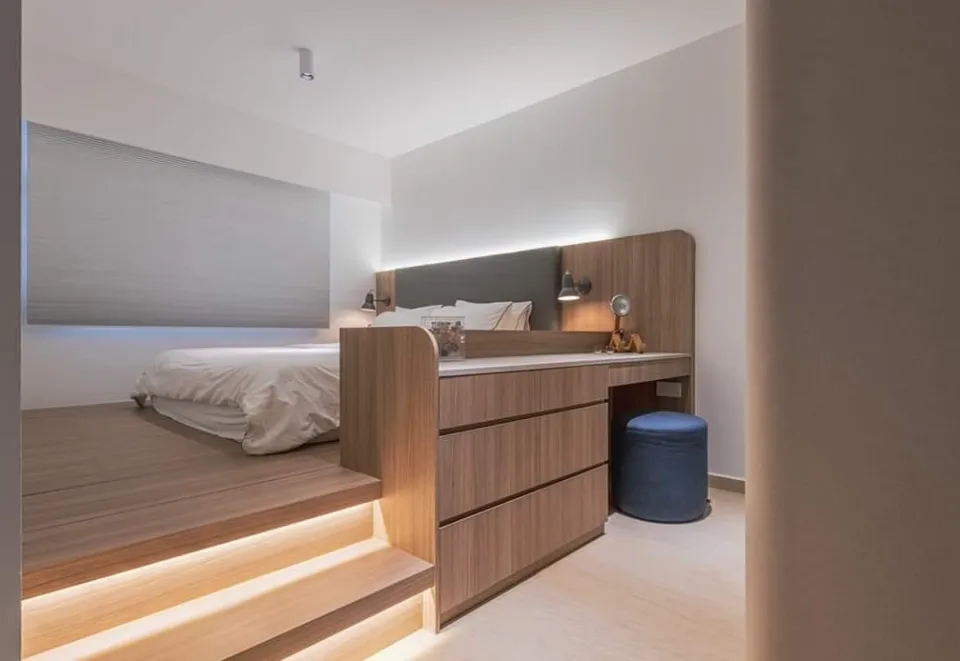
Platform Beds Vs. Box Springs
Here are the details:
Dimensions
The size and maker of your mattress will determine the dimensions of your platform bed or box spring.
When it comes to weight, platform beds are much heavier than box springs which could make it difficult to move around. Box spring beds are typically much heavier if you include the weight of the bed frame and the box spring.
Price
The brand, material, and size of each will have a significant impact on the price of the platform bed and box spring. Traditional box spring prices range from $100 to $500 on average (not including the price of a bed frame).
Platform beds, on the other hand, can range in price from a few hundred to several thousand dollars, but they don’t need any additional mattress accessories to be set up. Platform beds typically cost less because they need fewer extra accessories.
Comfort
The platform bed versus the box spring debate. box spring comfort debate, both can enhance the comfort of your bed. The kind of mattress you have, though, will determine this.
Box springs can make beds more comfortable if you have an innerspring mattress. They work with the coils in innerspring mattresses to:
- Add support
- Absorb body weight
- Ease aches for people who sleep with back pain
However, box springs don’t have much airflow, so they don’t work with other mattress types and can trap heat.
On the other hand, platform beds are breathable and ideal for all mattresses. A platform bed will keep you cool at night if you tend to sleep hot. The air is circulated throughout the mattress. When purchasing a platform bed, pay attention to the size of the slats and the space between them. You’ll have more support the more closely spaced the slats are from one another.
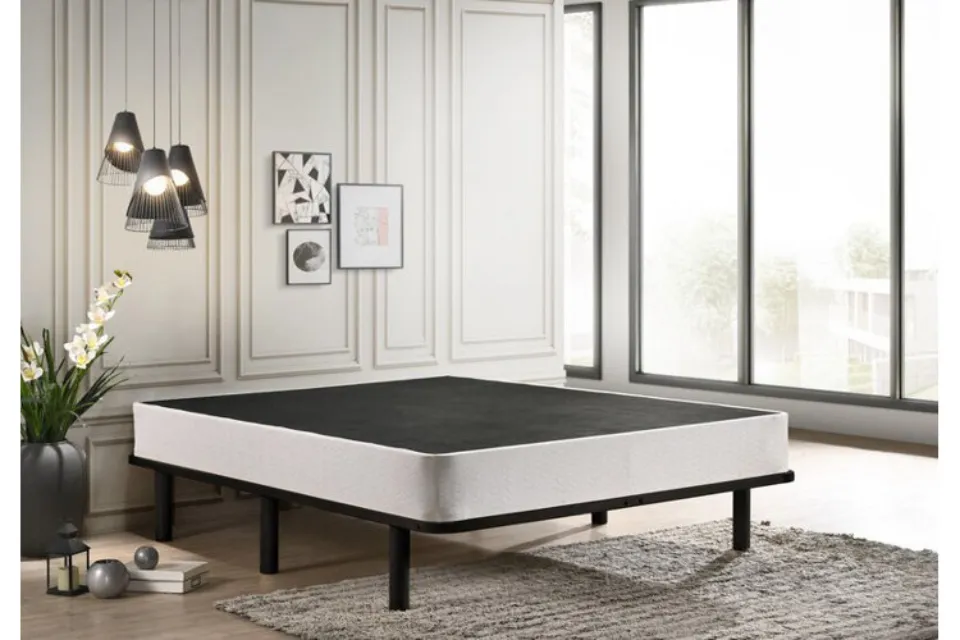
Storage Space
People who live in small spaces or require additional storage space frequently choose platform beds with built-in storage. So that you can make the most of the space in your room, the storage drawers are located under the bed. There are also platform beds that have built-in bookshelves for additional storage.
Not much storage space is provided by box springs. The area under the bed can be used for storage if your box spring is elevated from the floor.
Compatibility
Because it can accommodate the majority of mattress types, including memory foam, latex, and hybrid mattresses, a platform bed is more compatible than a box spring. Mattresses with innersprings work best with box springs.
So, how do you choose between the two? To summarize: A box spring is a mattress foundation that can be placed on a bed frame and a platform bed is a bed frame with a foundation built-in.
Can You Use a Box Spring on a Platform Bed?
A box spring can be used with a platform bed, yes. Although it’s not necessary. You do not need a box spring if your bed is a platform and you feel comfortable with the height. But you can add a box spring if you want your bed to be a bit taller.
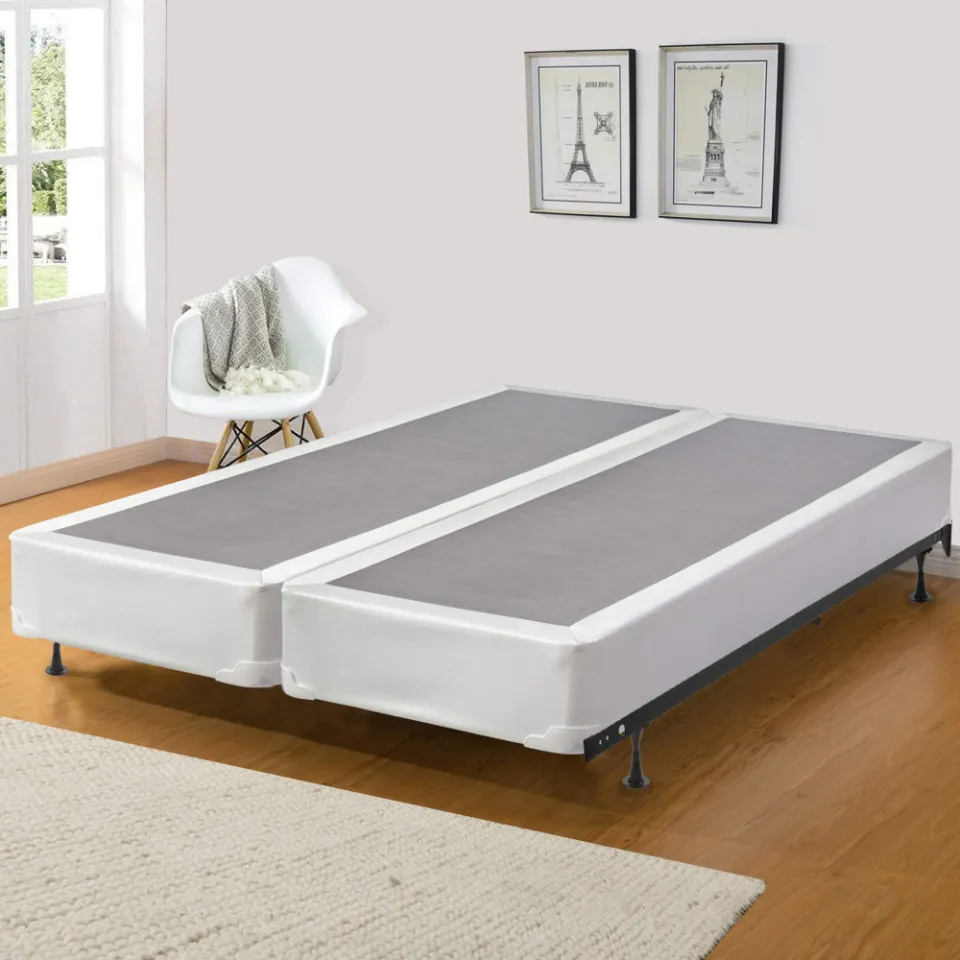
FAQs
Can I Pair a Box Spring With a Platform Bed?
Platform beds and box springs have a similar function, so they are not frequently paired together. If you prefer a higher bed, some platform bed styles can be combined with a box spring. To determine whether your platform bed can support a box spring, make sure to read the specific instructions that are included with it.
Can I Pair a Bunkie Board With a Memory Foam Mattress?
Yes, it’s generally recommended to pair memory foam mattresses and hybrid mattresses with a bed that utilizes a solid base. A mattress foundation would also work and give your memory foam mattress all the support it needs, though it would be preferable to use a bunkie board instead of a box spring.
What’s the Difference Between a Platform Bed and a Mattress Foundation?
A wooden box with a slatted frame for added firmness and durable support makes up a mattress foundation. The majority of mattress types are supported by mattress foundations, which are typically covered in a breathable fabric. The mattress foundation will not have any storage spaces, a headboard, or a footboard like a platform bed does.
The right bed base for you will depend on your mattress type and how high you want your mattress to sit.
What’s the Difference Between a Platform Bed and a Futon?
The concept of a platform bed and a futon are similar in some ways, but the main distinction is that a futon can be used as both a bed and a couch, and it can be folded completely, whereas platform beds can only be used as beds.
What is a Euro-style Slat System?
A slat platform bed’s slat configuration is referred to by this phrase. The dual-sided, flexible wooden slats and wooden frame that make up the euro-style slat system are used. For increased comfort, these flexible slats will move under pressure in response to the position and weight of your body.
Summary: Should You Buy a Platform Bed?
Platform beds offer a sleek, modern aesthetic, and can be a great option for sleepers wanting to skip the traditional boxspring. The supportive base, whether solid, slatted, metal, or something in between, provides a sturdy foundation for your mattress.
Platform beds are not suitable for all sleepers, though. If you have trouble getting in and out of bed or suffer from back pain, a platform bed may not be the right choice, since the lower height makes them inherently more difficult to get in and out of.
If you have any questions, please leave a comment. My Prime Home tries to give you the best home improvement information. Don’t forget to share the post. Thank you for reading.
You may want to know:
